Special Report
The Weapons Used in 21 of the Most Infamous Assassinations

Published:

Any single individual, no matter their station in life, is capable of altering the course of human history with little more than a motive and a gun. The world as we know it today is in no small way the product of a handful of assassinations – or murders – often carried out for political reasons.
While assassinations likely extend further back in time than history books can go, and while other weapons can certainly be used for the task (see Julius Caesar), the advent of the firearm has fundamentally transformed assassination in recent centuries. Guns are something of an equalizer, and a would-be assassin who has one does not need to physically overpower their victim, or even be in close proximity. To achieve their goals, they need only point their firearm in the right direction and pull the trigger.
In the 20th century alone, a handful of assassinations carried out with guns brought about unintentional, unforeseeable, and often devastating consequences. The 1914 assassination of Austria-Hungary’s Archduke Franz Ferdinand in Sarajevo, for example, is widely seen as the catalyst for World War I, which itself sowed the seeds for World War II.
Similarly, the 1901 assassination of President William McKinley in Buffalo, New York, and the 1963 assassination of President John F. Kennedy in Dallas, resulted in the political ascendance of Theodore Roosevelt and Lyndon Johnson, respectively – two of the most impactful presidents in American history. (Here is a look at 24 assassinations that changed the course of history.)
Consulting historical documents and official government records, 24/7 Tempo identified the guns used in some of the most notorious assassinations since the mid-19th century. While most of the victims of these assassinations were elected officials or leaders of political movements, some were also entertainers or notorious criminal figures themselves.
Click here to read about the weapons used in 21 of the most infamous assassinations
Most of these assassinations were carried out by a lone gunman, motivated by political ideology, vengeance, insanity, or some combination of the three. Often, the victims of these assassinations were killed by a handgun, fired at close range – though there are several cases, like those of Rev. Martin Luther King Jr. and President John F. Kennedy, in which the assassin fired at distance with a high-powered rifle.
In some cases, the guns used in these assassinations have been destroyed or gone missing. Others are currently held at museums, or have been sold to private bidders. (Here is a look at the most expensive firearms ever sold at auction.)

Carcano M91/38 rifle
> Victim: President John F. Kennedy (1963)
> Assassin: Lee Harvey Oswald
> Location: Dallas, Texas
> Date: Nov. 22, 1963
On March 12, 1963, Lee Harvey Oswald purchased an Italian-made, bolt-action, Carcano M91/38 military surplus rifle for $19.95 – just under $200 in today’s dollars – from an ad in American Rifleman magazine. Just eight months later, on Nov. 22, 1963, Oswald used that same rifle to carry out one of the most notorious assassinations in U.S. history.
Firing three shots into President John F. Kennedy’s motorcade from a 6th floor window of the Texas School Book Depository in Dallas’ Dealey Plaza, Oswald struck the 35th President of the United States once in the chest and once in the head with two 6.5x52mm-caliber bullets. The wounds proved fatal, and led to Lyndon B. Johnson, Kennedy’s vice-president, taking the oath of office later that day.
[in-text-ad]

Remington Model 760 Gamemaster rifle
> Victim: Rev. Martin Luther King (1968)
> Assassin: James Earl Ray
> Location: Memphis, Tennessee
> Date: April 4, 1968
Civil rights leader Rev. Martin Luther King Jr. stepped out of his room and out onto the balcony of a hotel in Memphis on April 4, 1968, moments before being struck in the right cheek by an assassin’s bullet. An hour later, he was pronounced dead at St. Joseph’s Hospital.
The bullet was fired from a second-story bathroom window from a boarding house across the street by a racist World War II veteran and ex-con, James Earl Ray. Ray used a pump-action, Remington Model 760 Gamemaster rifle. Ray first purchased a rifle chambered for .243 caliber ammunition on March 29, 1968, but exchanged it for a more powerful .30-06 rifle the next day – the rifle he would use to kill King days later. Ray left the rifle bearing his fingerprints near the crime scene before fleeing the country. Ray was ultimately caught and extradited back to the U.S., where he confessed to the crime.

.22 caliber Iver-Johnson Cadet revolver
> Victim: Senator Robert Kennedy (1968)
> Assassin: Sirhan Sirhan
> Location: Los Angeles, California
> Date: June 5, 1968
At a June 5th campaign stop in 1968 at the Ambassador Hotel in Los Angeles, Democratic senator Robert Kennedy was gunned down by an assassin. Killed less than five years after his brother John F. Kennedy, the 35th President of the United States, Robert Kennedy was targeted by Sirhan Sirhan, a Christian Palestinian who disagreed with the politician’s support for Israel.
The firearm Sirhan used was a .22 caliber Iver-Johnson Cadet revolver. Despite the firearm’s small caliber, the shots that hit Kennedy – one in the head and two in the back – were fired at point blank range, and proved fatal. Senator Kennedy was pronounced dead at Good Samaritan Hospital on June 6, 1968.

.40 caliber Glock
> Victim: Tupac Shakur
> Assassin: Unknown
> Location: Las Vegas, Nevada
> Date: Sept. 7, 1996
On the evening of Sept. 7, 1996, rapper Tupac Shakur was sitting in a passenger seat at a stop light in Las Vegas when a white Cadillac pulled up next to his vehicle. An unknown assailant in the Cadillac fired at least 12 shots at Shakur, four which hit him in the chest. Though emergency surgery at University Medical Center kept him alive that night, Shakur ultimately died of his wounds on Sept. 13, 1996.
Though the identity of the assassin remains unknown, the weapon used in the killing is believed to have been a .40 caliber semi-automatic Glock handgun, which was discovered in a backyard in Compton, California, in 1998. Earlier in the night of the shooting, Shakur had attended a Mike Tyson boxing match and got into an altercation with a man identified as a member of the Crips street gang in the MGM Grand Hotel lobby. Any connection between the murder and the confrontation, or to Shakur’s highly-publicized feud with East Coast rapper the Notorious B.I.G., has never been legally established.
[in-text-ad-2]
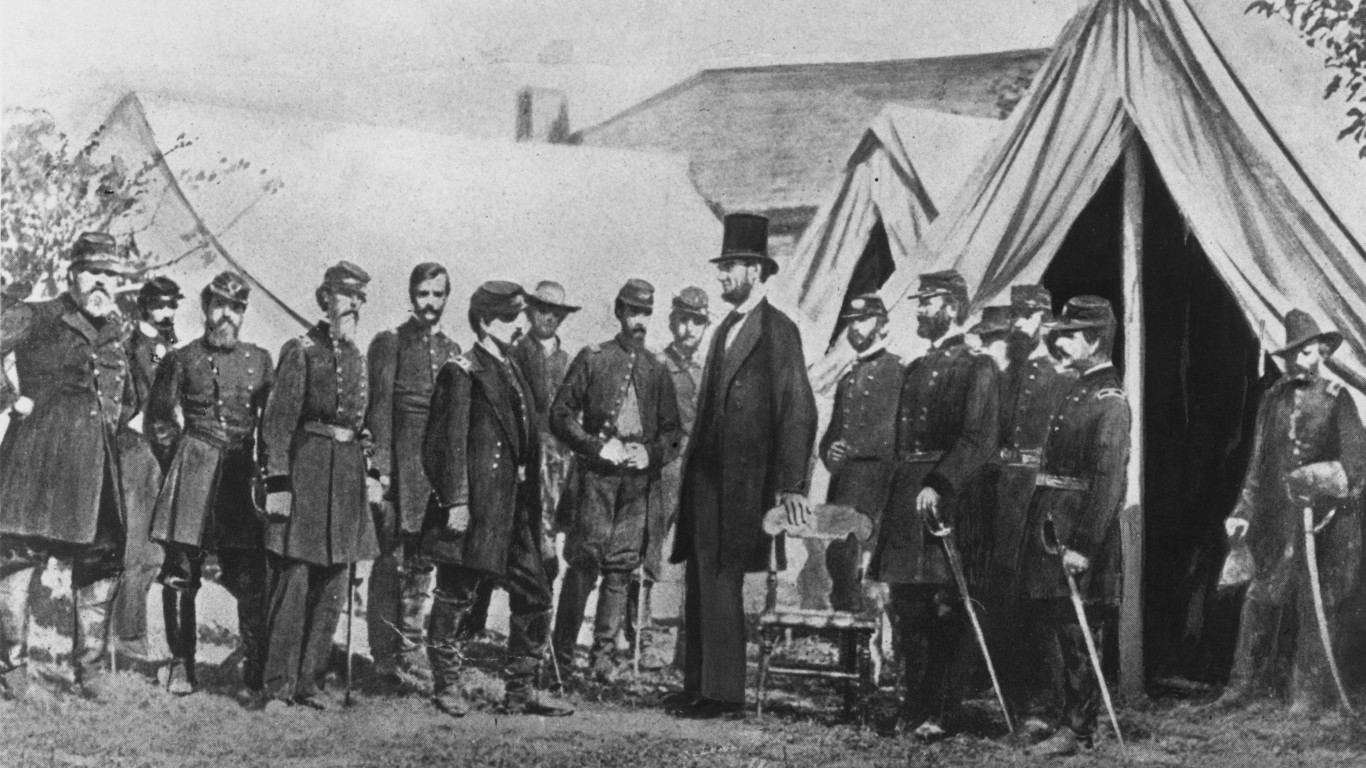
.44 caliber Philadelphia Derringer pistol
> Victim: President Abraham Lincoln
> Assassin: John Wilkes Booth
> Location: Washington, D.C.
> Date: April 14, 1865
On the evening of April 14, 1865, Good Friday, President Abraham Lincoln attended a stage production of “Our American Cousin” at Ford’s Theatre in Washington D.C. Towards the end of the performance, John Wilkes Booth, a slavery advocate and supporter of the Southern cause, entered the presidential box and shot Lincoln in the back of the head at point blank range. The president was pronounced dead the following day.
Booth used a single-shot .44 caliber derringer pistol to carry out the assassination. Less than six-inches in length, the derringer was easily concealed. Upon firing, Booth dropped the pistol, which is now on display at Ford’s Theatre National Historic Site. Booth managed to escape, but was located less than two-weeks later at a tobacco farm in Virginia, where he died of a gunshot wound.

Charter Arms .38 caliber pistol
> Victim: John Lennon
> Assassin: Mark David Chapman
> Location: New York City, New York
> Date: Dec. 8, 1980
John Lennon was gunned down in New York City on the evening of Dec. 8, 1980 near the entrance to the Dakota, where he had an apartment. His assailant, Mark David Chapman, had gotten an autograph and had a photo taken with the former Beatle earlier that day.
Chapman carried out the murder with a Charter Arms .38 caliber revolver. He fired five shots, four of which struck Lennon in the back and shoulder. A long-time Beatles fan, Chapman reportedly turned on Lennon when he claimed, in 1966, that the Beatles were bigger than Jesus. Following the murder, Chapman was determined to be borderline psychotic.
[in-text-ad]

.38 caliber Colt Cobra revolver
> Victim: Lee Harvey Oswald
> Assassin: Jack Ruby
> Location: Dallas, Texas
> Date: Nov. 24, 1963
On Nov. 24, 1963, two days after President Kennedy’s assassination, the alleged shooter, Lee Harvey Oswald, was being escorted through the basement of Dallas police headquarters on his way to a more secure jail. Among the gathered crowd of onlookers, reporters, police officers, was Jack Ruby, a Dallas nightclub operator well known to police.
Ruby stepped through the crowd carrying a .38 caliber Colt Cobra revolver. He lunged at the handcuffed Oswald and fired a single shot into his abdomen that would ultimately prove fatal. The incident was broadcast on live television. Ruby claimed he carried out the attack so that Jaqueline Kennedy, the wife of the late John F. Kennedy, would not have to return to Dallas for the trial of her husband’s murder. Ruby’s revolver, which he bought for $62.50, sold at auction in December 1991 for $220,000 – $481,500 in today’s dollars.
Smith & Wesson Model 36 Chief’s Special
> Victim: Mayor George Moscone and Harvey Milk
> Assassin: Dan White
> Location: San Francisco, California
> Date: Nov. 27, 1978
Harvey Milk was in office as a member of the San Francisco Board of Supervisors for less than a year before he was assassinated. One of the first openly gay politicians in the United States, Milk, along with San Francisco mayor George Moscone, was gunned down by Dan White, himself a former member of the Board of Supervisors on Nov. 27, 1978. White reportedly targeted the two after not being reappointed to the city board and because of opposition to their police violence and abuse.
Both Milk and Moscone were shot twice in the head and multiple times in the body with a .38 caliber Smith & Wesson Model 36 Chief’s Special. The gun was later destroyed by a clerk who worked in the police headquarters’ property room, with a vice, a sledgehammer, a hacksaw, and bolt cutters.
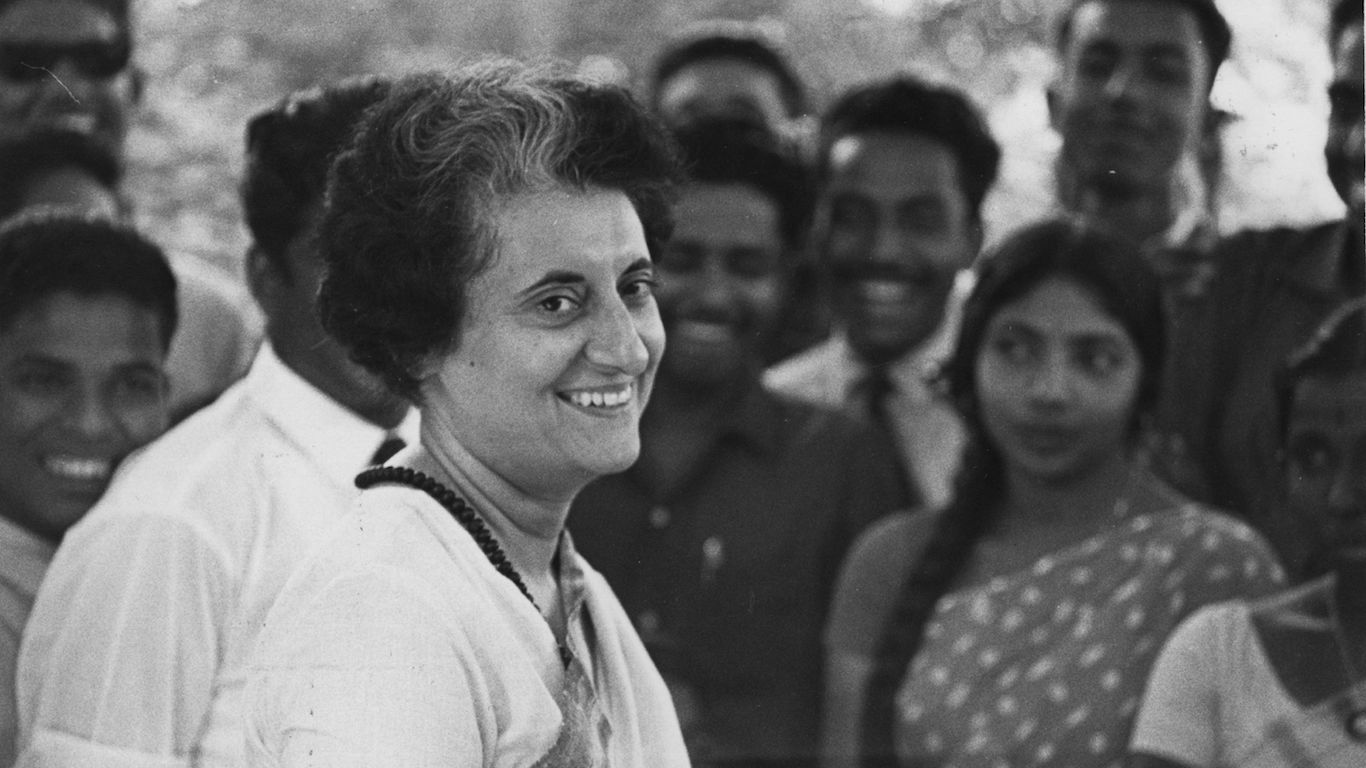
.38 revolver and 1A submachine carbine
> Victim: Prime Minister Indira Gandhi
> Assassins: Beant Singh and Satwant Singh
> Location: New Delhi, India
> Date: Oct. 31, 1984
On Oct. 31, 1984, Prime Minister Indira Gandhi of India was gunned down outside her home in New Delhi by two members of her security detail. The bodyguards-turned-assassins, Satwant Singh and Beant Singh, both Sikhs, killed the prime minister as retribution for her ordering Operation Blue Star, in which in the nation’s army stormed the Sikh Golden Temple earlier in the year, resulting in the death of a Sikh leader and many followers.
When Gandhi was walking through her garden for a television interview, one of her bodyguards fired three rounds from a .38 special revolver, hitting the leader in the abdomen. The second guard then fired his 1A submachine gun at Gandhi, emptying all 30 rounds. The 1A SMG was an Indian-made copy of the British Sterling SMG.
[in-text-ad-2]

Sawed-off 12-gauge shotgun; .45 ACP and 9mm handguns
> Victim: Malcolm X
> Assassins: Thomas Hagan/Talmadge Hayer/Mujahid Halim; others unknown
> Location: New York City, New York
> Date: Feb. 21, 1965
Civil rights leader Malcolm X addressed a meeting of the Organization of Afro-American Unity at Harlem’s Audubon Ballroom on Feb. 21, 1965. Some 400 people were in attendance, including Thomas Hagan, also known as Talmadge Hayer and later as Mujahid Halim. He and two other men, believed to be members of the Nation of Islam (which had been feuding with Malcom X), carried a sawed-off 12 gauge shotgun, a .45 caliber handgun, and a 9mm handgun and fired when he was on stage. When the gunfire stopped, Malcolm X was transported to New York’s Presbyterian Hospital, where he was pronounced dead with projectiles from each weapon found in his body.
Halim and two other men – Norman 3X Butler and Thomas 15X Johnson – were convicted of the murder, but Halim insisted from the start that they had not been involved in the shooting, and in 2022, they were exonerated, with the city of New York paying them a $26 million settlement.
.32 Iver Johnson revolver
> Victim: President William McKinley (1901)
> Assassin: Leon Czolgosz
> Location: Buffalo, New York
> Date: Sept. 6, 1901
On a trip to Buffalo, on Sept. 6, 1901, President William McKinley visited the Pan-American Exposition where he greeted many of those who had come out to see him. One of them was Leon Czolgsz, an anarchist. When McKinley reached out to shake Czolgsz’s hand, the assassin drew a revolver with his free hand and fired, hitting McKinley twice in the abdomen. Though he was treated at the Exposition’s Hospital, the 25th president of the United States succumbed to his wounds less than two weeks later.
Three days before turning it on the president, Czolgsz had purchased a .32 caliber Iver Johnson revolver for $4.50, likely over $140 in today’s dollars.
[in-text-ad]

Beretta M1934 semi-automatic pistol
> Victim: Mahatma Gandhi
> Assassin: Nathuram Godse
> Location: New Delhi, India
> Date: Jan. 30, 1948
A champion of non-violent resistance, Mahatma Gandhi became the leader of the movement for Indian independence from British rule. On Jan. 30, 1948, he was assassinated in New Delhi by Nathuram Godse, a Hindu extremist who objected to Gandhi’s acceptance of Muslims.
Under the pretext of touching his feet during his evening prayers, Godse emerged from a crowd of people and approached Gandhi, fatally shooting him three times with a Beretta M1934 semi-automatic. A compact handgun chambered for .380 ACP ammunition, the Beretta model was used widely by Axis powers in World War II and relatively rare in India.
.380 caliber FN Model 1910 semi-automatic pistol
> Victim: Archduke Franz Ferdinand
> Assassin: Gavrilo Princip
> Location: Sarajevo, Bosnia-Herzegovina
> Date: June 28, 1914
Perhaps no single assassination has had a greater impact on the course of world history in recent centuries than the assassination of Austro-Hungarian archduke Franz Ferdinand. Seen as the catalyst for World War I, which itself sowed the seeds for the Second World War, the murder took place while Ferdinand was traveling in a motorcade through Sarajevo in the region of Bosnia-Herzegovina, recently annexed by the Austro-Hungarians.
His route through the city, which was made public, was lined with onlookers, and among them was 19-year-old Gavrilo Princip, a member of the anti-Austrian revolutionary group known as Young Bosnia. After several of Princip’s co-conspirators failed to assassinate the Archduke earlier in the procession, Princip approached Ferdinand’s vehicle cand fired the small, concealable, FN M1910 .380 semi-automatic pistol he was carrying, striking his target in the neck and mortally wounding him. The incident resulted in Austrian authorities arresting 5,000 Serbs in Sarajevo and killing or executing 1,000 of them, sparking Europe’s descent into World War I one month later.
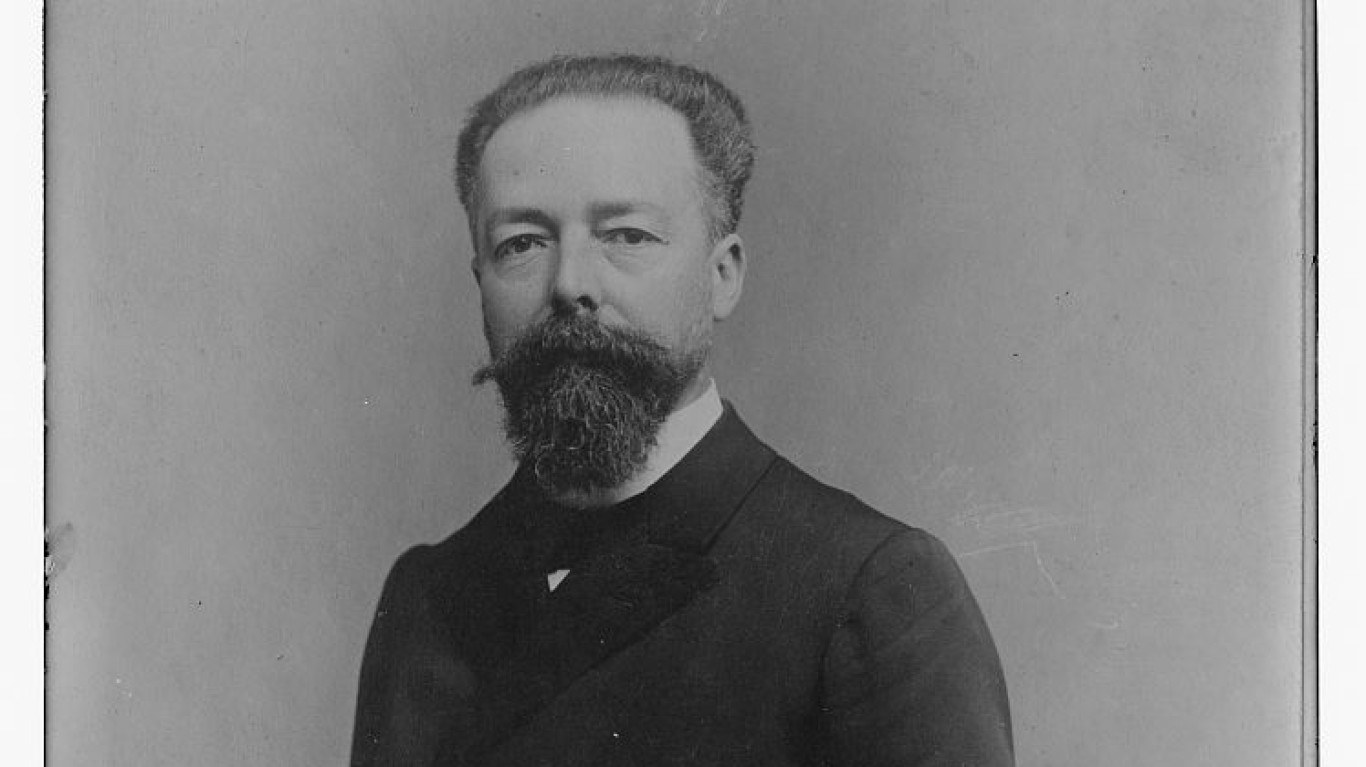
.32 caliber FN Model 1910 semi-automatic pistol
> Victim: President Paul Doumer of France
> Assassin: Pavel Timofeyevich Gorgulov
> Location: Paris, France
> Date: May 6, 1932
Less than one year after being elected to office, French president Paul Doumer was assassinated on May 6, 1932 by Russian émigré and World War I veteran Pavel Timofeyevich Gorgulov while visiting a book fair in a Paris hotel.
Motivated by the belief that France had not done enough to support opposition to Bolshevism during the Russian Civil War, Gorgulov brought a .32 caliber FN Model 1910 semi-automatic pistol to the fair, where he shot the French president several times in the back. Hit in the right armpit and at the base of his skull, Doumer died the following day at Beaujon Hospital. The pistol used in the assassination is now held at the Musée des Collections Historiques de la Préfecture de Police in Paris.
[in-text-ad-2]
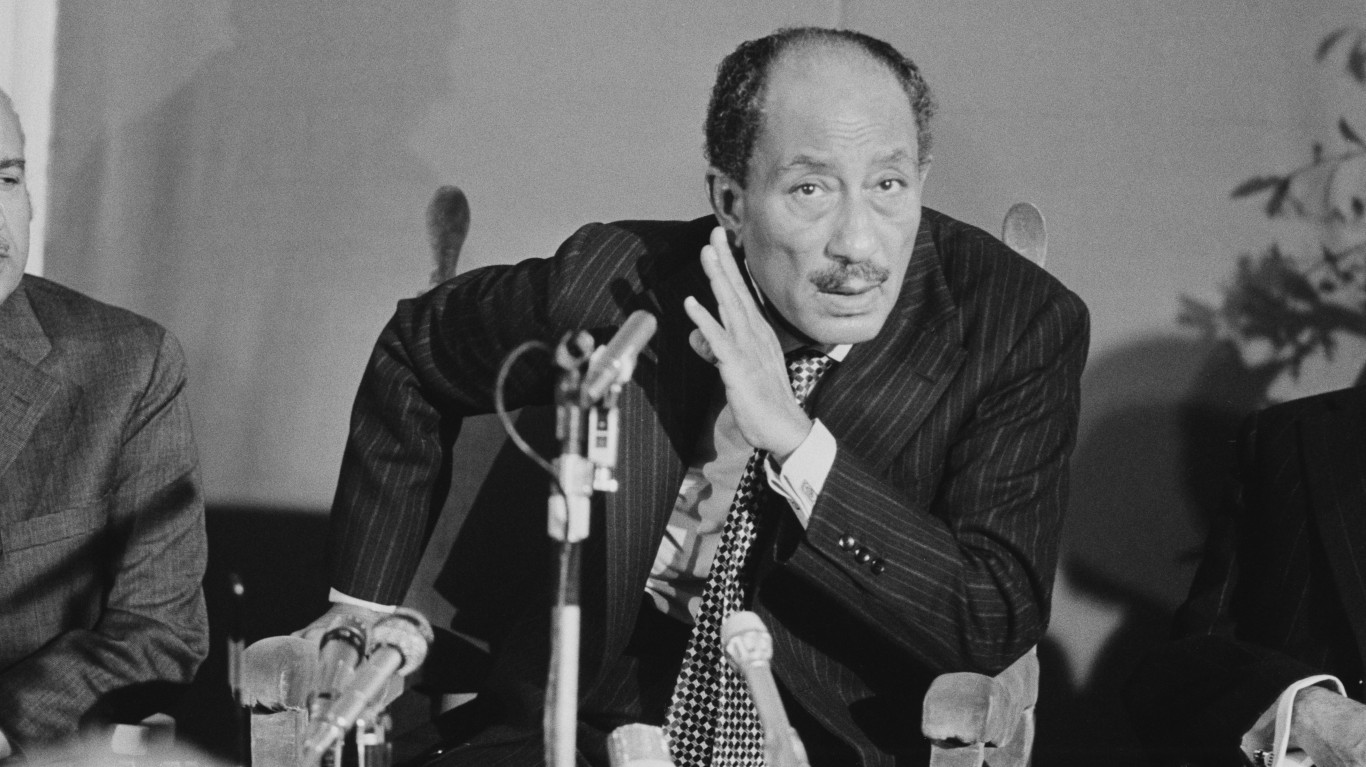
Port Said submachine gun, AK-47
> Victim: Egyptian president Anwar Sadat
> Assassins: Egyptian soldiers led by Lieutenant Khalid Islambouli
> Location: Cairo, Egypt
> Date: Oct. 6, 1981
During an annual celebration of Egypt’s crossing of the Suez Canal during the Yom Kippur War, Egyptian president Anwar Sadat was assassinated by a team of Islamist terrorists in Cairo. The terrorists – Egyptian soldiers led by Lieutenant Khalid Islambouli – jumped out of military vehicles during the parade and, armed with automatic weapons, began firing and lobbing grenades at the presidential viewing stand – killing Sadat and at least 10 other dignitaries.
To carry out the assassination, Egyptian troops used a Port Said submachine gun, a copy of the Swedish M45/b SMG that was issued to Army officers, as well as several AK-47s. The Port Said SMG was used by the Egyptian military for over 30 years.
.44 caliber Webley British Bulldog pistol
> Victim: President James Garfield (1881)
> Assassin: Charles J. Guiteau
> Location: Washington, D.C.
> Date: July 2, 1881
After stalking President James Garfield, Charles J. Guiteau shot the 20th president of the United States twice on the morning of July 2, 1881 at a Washington D.C. train station. mortally wounding him. The assassination was motivated by the gunman’s belief that then-Vice-President Chester A. Arthur was better suited to the job of restoring the values of the Republican Party.
The pistol Guiteau used to shoot the president was a Belgian made .44 caliber Webley British Bulldog revolver he had reportedly purchased for $10. Though Garfield survived for 80 days after the attack, he eventually succumbed to infections caused by the bullet wounds, and died on Sept. 18, 1881.
[in-text-ad]

.32 caliber US Revolver Company pistol
> Victim: Chicago mayor Anton Cermak
> Assassin: Giuseppe Zangara
> Location: Miami, Florida
> Date: Feb. 15, 1933
Following a fishing trip in the Bahamas, President Franklin Roosevelt gave a short speech from his car in Miami, Florida, on the evening of Feb. 15, 1933. Following the speech, the president met with Chicago mayor Anton Cermak. When Cermak got up to leave Roosevelt’s vehicle, Italian immigrant Giuseppe Zangara approached and fired five shots, intended for the president – later telling police he wanted to kill kings, presidents, and all capitalists. However, Zangara missed his target, and hit Cermak and four bystanders instead.
Transported to Jackson Memorial Hospital, Cermak succumbed to complications 19 days later. Days before the attack, Zangara had purchased a five-shot .32 caliber United States Revolver Company pistol – the gun he would use in the attack – from a pawn shop for $8, or about $190 in today’s dollars.
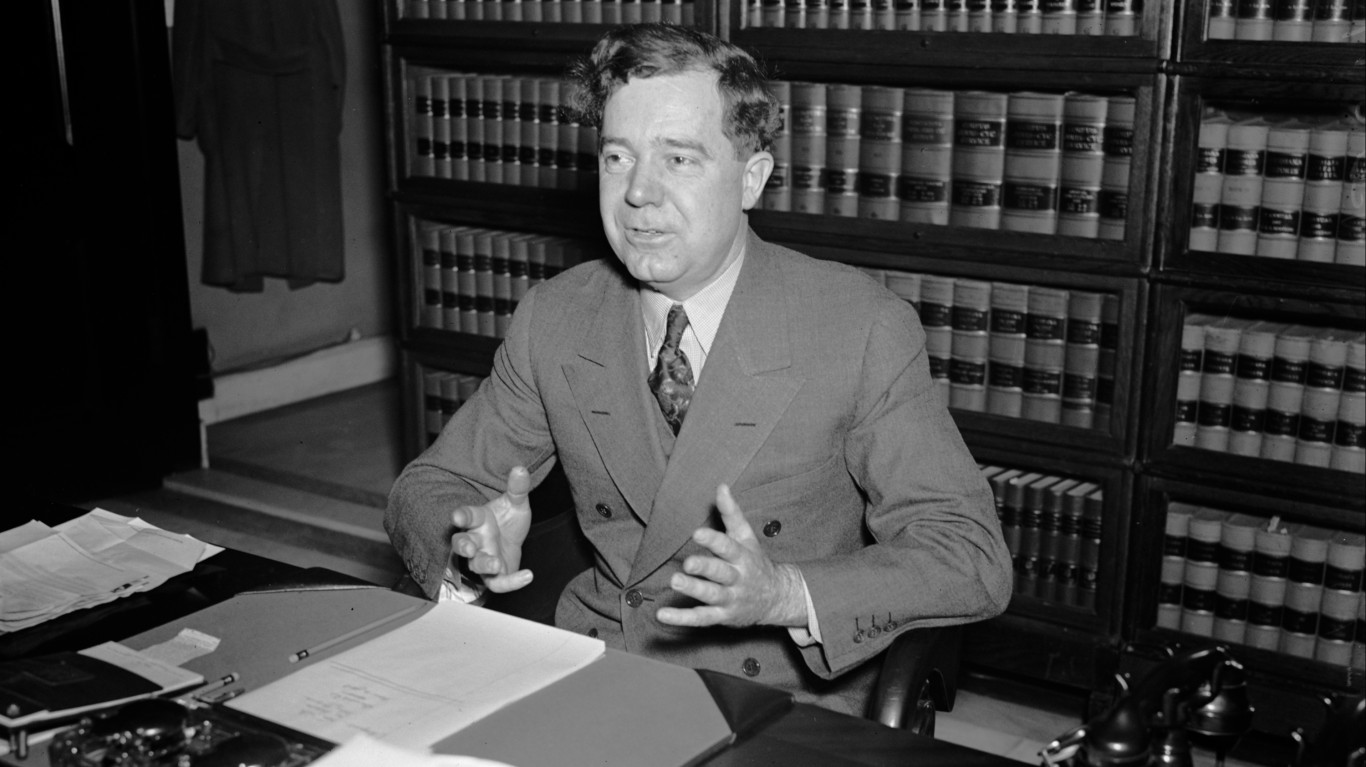
Browning 7.65 millimeter automatic pistol
> Victim: Senator Huey Long
> Assassin: Carl A. Weiss
> Location: Baton Rouge Louisiana
> Date: Sept. 8, 1935
U.S. Senator Huey Long of Louisiana had a controversial political career. Sworn in at age 34 in 1928, he became the youngest governor of the state. As governor, he favored heavy taxes on the rich to redistribute wealth, and ultimately developed policies that would have guaranteed a $2,500 minimum income for Louisiana families. Later elected to the U.S. Senate, Long broke with his former ally, President Franklin Roosevelt and was planning to run against him in the upcoming presidential campaign.
Through much of his political career, Long was the target of death threats, none of which would meaningfully materialize, until Sept. 8, 1935. While attending a special legislative session at the State House in Baton Rouge, Long was approached by Dr. Carl Weiss, the son-in-law of one of his political opponents. Weiss was carrying a Browning 7.65 millimeter automatic pistol, which he reportedly fired at close range into Long’s abdomen, delivering a wound that would prove fatal two days later.

Smith & Wesson Model 36 revolver
> Victim: President Park Chung-hee of South Korea
> Assassin: Kim Jae-Kyu
> Location: Seoul, South Korea
> Date: Oct. 26, 1979
Formerly a general in the armed forces, Park Chung-hee assumed South Korea’s presidency in 1963 following a military coup. As president, Chung-hee oversaw an era of massive economic expansion in the country, while at the same time undermining democratic values, civil liberties, and political freedoms.
Over dinner on the evening of Oct. 26, 1979, Chung-hee chastised his longtime associate, Kim Jae-Kyu, head of Korean Secret Police, not using violent means to quash mass protests in Busan. Enraged, Kim Jae-Kyu went to his room and retrieved a semi-automatic Walther PPK pistol. Jae-Kyu intended to shoot the head of the presidential guard before shooting the president himself, but his Walther jammed before he could fire. He then borrowed a Smith & Wesson Model 36 revolver from one of his bodyguards, and used it to execute the president.
[in-text-ad-2]
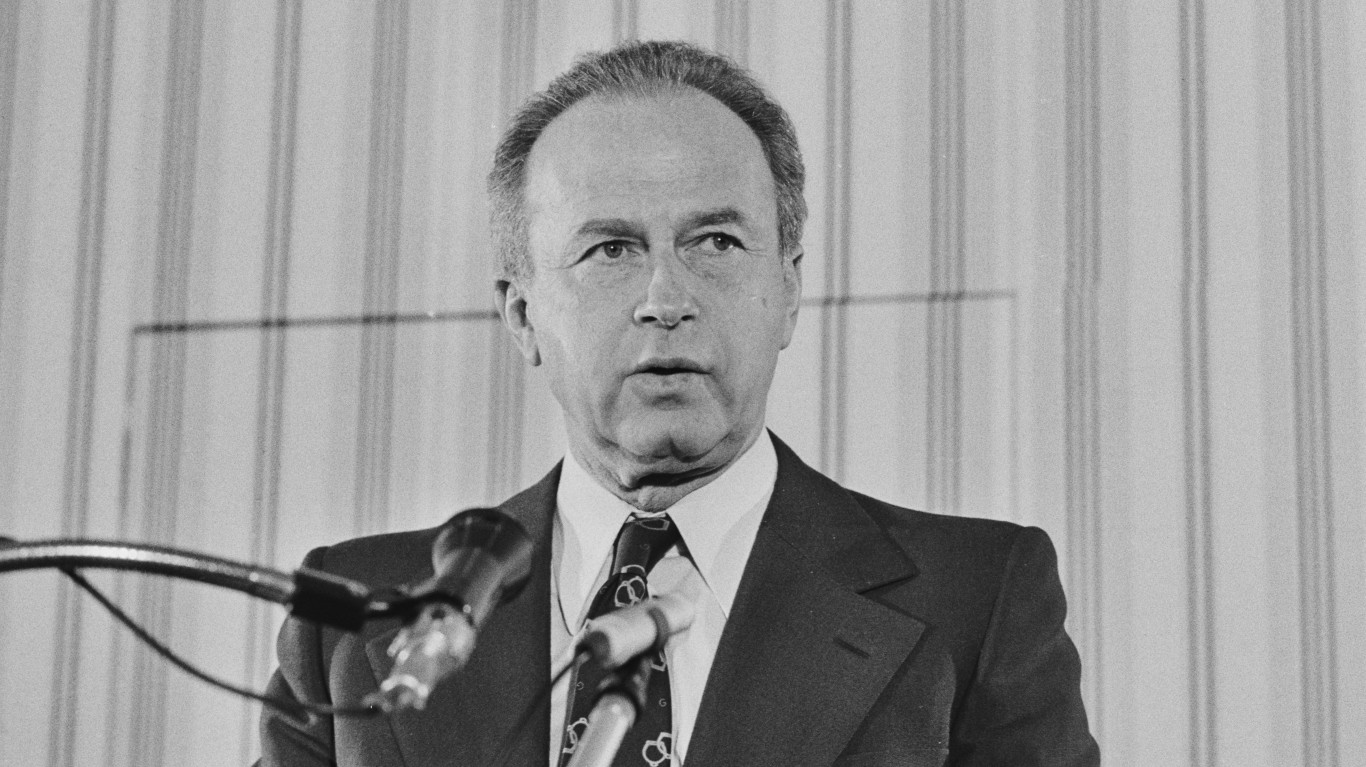
Beretta 84F .380 caliber ACP semi-automatic pistol
> Victim: Israeli prime minister Yitzhak Rabin
> Assassin: Yigal Amir
> Location: Tel Aviv, Israel
> Date: Nov. 4, 1995
On Nov. 4, 1995, Prime Minister Yitzhak Rabin of Israel attended a peace rally in Tel Aviv’s Kings Square. There were an estimated 100,000 people in attendance, including a young far-right Israeli Jew, Yigal Amir. When walking to his car, the prime minister – who notably had refused to wear a bulletproof vest that day – was approached by Amir, who shot him twice, once in the arm and once in the back. Rabin died hours later in a nearby hospital.
Amir used a Beretta 84F semi-automatic pistol loaded with a mix of regular and hollow point bullets. In his confession to the police, Amir claimed that the prime minister wanted “to give our country to the Arabs.”
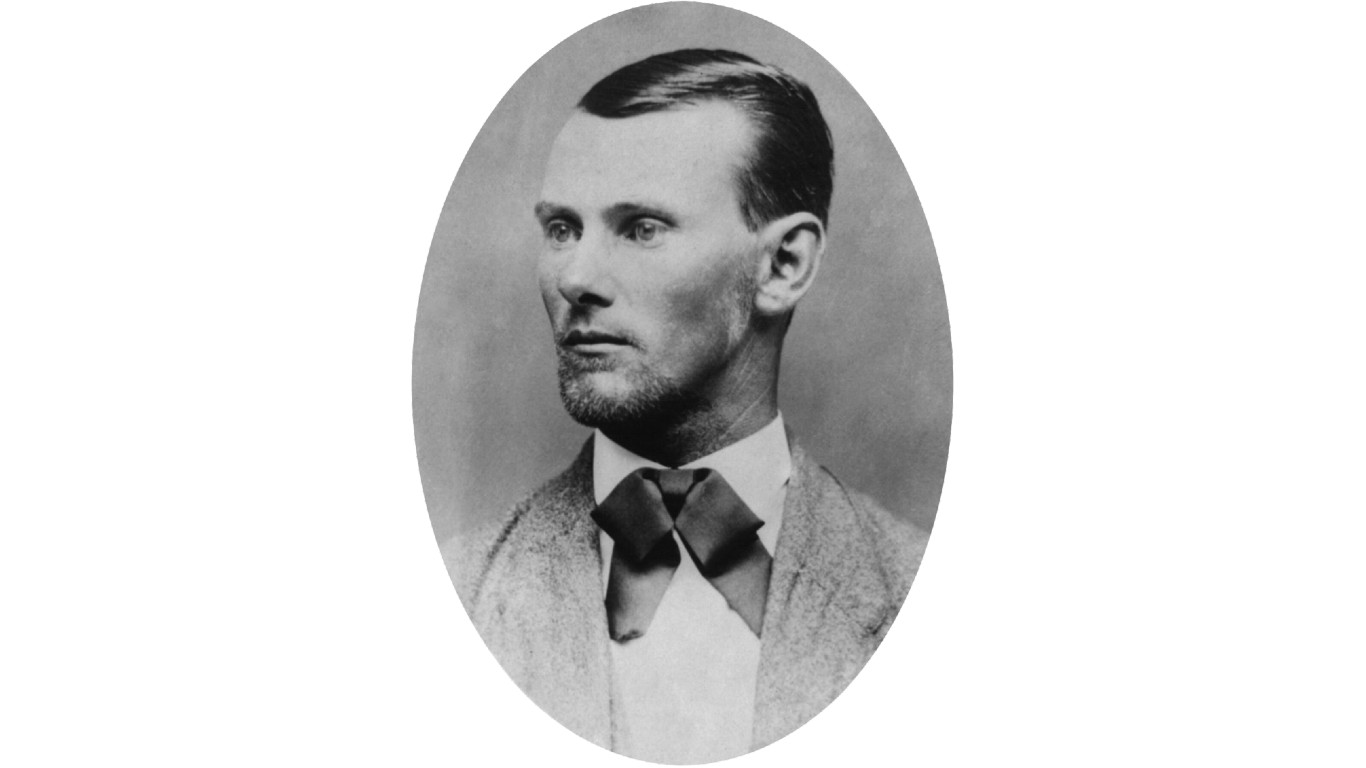
New Model No. 3 single-action .44 caliber Smith & Wesson revolver
> Victim: Jesse James
> Assassin: Robert Ford
> Location: St. Joseph, Missouri
> Date: April 3, 1882
After 16 years as the leader of the James Gang outlaws, robbing banks, stagecoaches, and trains, Jesse James was gunned down in a St. Joseph home on April 3, 1882. His assassin was Robert Ford, a member of his own gang, who reportedly killed James to collect the $10,000 bounty on his head, offered by Missouri governor Tom Crittenden.
The gun Ford used to carry out the assassination was a New Model No. 3 single action .44 caliber Smith & Wesson revolver. The same gun was sold at auction in November 2003 for $350,000, or over $570,000 today.
Retirement planning doesn’t have to feel overwhelming. The key is finding expert guidance—and SmartAsset’s simple quiz makes it easier than ever for you to connect with a vetted financial advisor.
Here’s how it works:
Why wait? Start building the retirement you’ve always dreamed of. Click here to get started today!
Thank you for reading! Have some feedback for us?
Contact the 24/7 Wall St. editorial team.